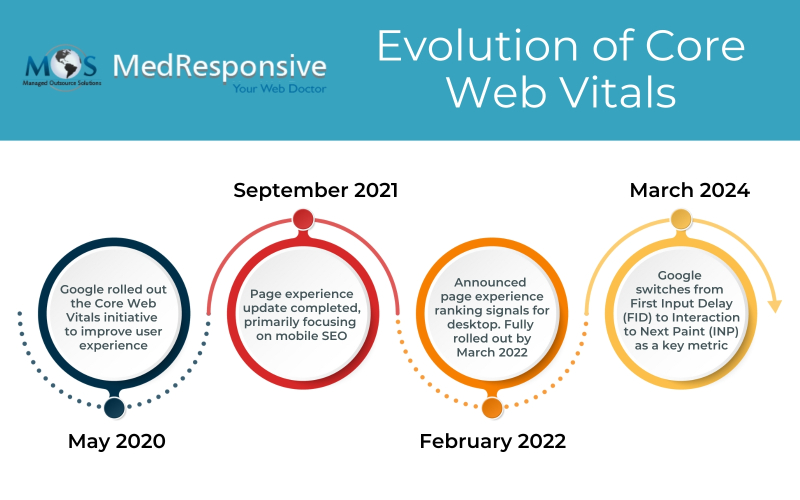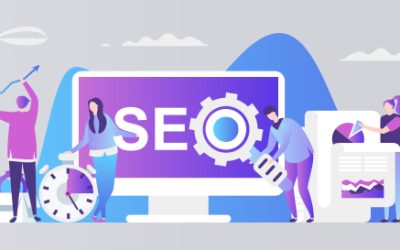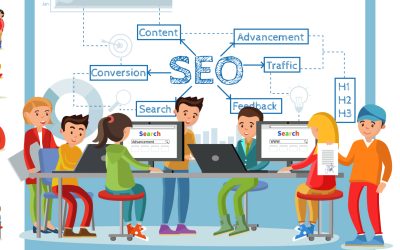Three Seconds.
If your website takes any longer than that, you can say goodbye to more than half of the visitors who were ready to engage with your content! In today’s fast-paced digital world, attention span is growing shorter everyday and that means, every second counts. You will only get one, quick shot at impressing your visitors. Miss it, and the price you pay could be high—lost visitors, lower engagement and higher bounce rates. This is where Core Web Vitals (CWV), come into play. CWV are a set of metrics introduced by Google to enhance user experience based on a website’s speed, interactivity and visual stability.
As one of the veteran SEO consulting services in the country, we have compiled a quick, but comprehensive guide on how you can optimize your website to meet the CWV standards and stand out in the crowd. Also, we have written a detailed blog on Core Web Vitals if you’d like to know more about it.
What Are Core Web Vitals?
Core Web Vitals are the key metrics used to measure a website’s performance from a user’s perspective. They primarily focus on three aspects of the user experience—loading, interactivity and visual stability.
- Largest Contentful Paint, or LCP: Measures how fast the largest visible content on the webpage loads.
- Cumulative Layout Shift, or CLS: Measures the visual stability of the webpage like, how often the content moves around unexpectedly, etc.
- Interaction to Next Paint, or INP: Measures how long it takes between a user action (e.g., a click) and the website’s response.
These metrics have a significant impact on your SEO ranking and therefore, it is vital to keep par with the CWV scores as apart from gaining loyal customers, it can also influence how users perceive your brand.
Core Web Vitals Checklist
Here’s the checklist for CWV, which can be utilized for your website to provide an enhanced user experience and align with Google’s criteria:
- Enhancing Load Times (Largest Contentful Paint)
- Image Optimization: Use images in WebP or AVIF formats and compress them without sacrificing quality, to reduce load time.
- Lazy Loading: This feature can optimize webpage loading by delaying loading of non-essential elements, until needed.
- Server Response Time: Utilize server with reduced time-to-first-byte (TTFB) and cache assets with relevant upgrades.
- CSS & Java Script (JS): Minify usage of redundant CSS/JS files which can improve the speed. Use tools like PurifyCSS or UglifyJS to filter out untidy codes.
- Upgrade Interactivity (Interaction to Next Paint)
- Cut down on Long Tasks: Break down JS execution to eliminate tasks exceeding 50 ms. Chrome DevTools can weed out these long tasks.
- Preload Key Elements: Preload critical resources like images, texts or scripts for faster interactive speeds. Use the tag.
- Remove JavaScript Bloat: Reduce JS scripts that hinder overall experience. Tools like Lighthouse can identify moot scripts.
- Browser Cache: Use browser cache to store commonly used elements to speed up loading on return visits.
- Improve Visual Stability (Cumulative Layout Shift)
- Set Exact Measurements: Preset attributes (height, width) for images, videos and adspaces to arrest sudden shifting of elements while loading.
- Utilize CSS for Animations: CSS-based animations are less likely to cause disruptions during loading, as opposed to JS-based ones.
- Mobile User-friendly
- Responsive Design: Make sure the design is fully responsive, readily adapting to varied screen sizes. This mitigates layout shifts and enhances LCP.
- Lightweight Frameworks: Choose gentle themes and frameworks that don’t unnecessarily drown the website with codes.
- Mobile-friendly Testing: Google’s tools like PageSpeed Insights or Mobile-friendly Tests to analyze your website’s mobile performance.
- Modern Techniques
- Critical CSS: Extricate critical CSS to precisely load above-the-fold content for better performance.
- Apply HTTP/2: Reduce load times, by utilizing multiplexing, that will serve multiple assets simultaneously.
- Reduce Redirects: Cut down on page redirects to minimize user wait times.
Why Are Core Web Vitals Vital for SEO?
Core Web Vitals are not just performance-metrics, they are business-critical as well. The following stats explain how CWVs are essential for a website’s SEO performance:
- Websites that optimize their CWVs see a 24% rise in user interaction and engagement. (TruAgency)
- Around 60% of the global traffic comes from mobile devices, demonstrating the need for a high CWV score for a website. (Statista)
- 53% of visitors abandon a website if it takes more than three seconds to load. (Google)
CWV has taken the centre stage this year, and stepping into 2025, its significance is only going to rise, in the upcoming Google algorithm updates. These metrics not only improve rankings, but also help deliver an appealing user experience that would drive public interest with visitors coming back regularly.
Collaborating with MedResponsive will ensure your website is both user-friendly and search-engine focused. We are a professional search engine optimization company specialized in crafting custom SEO strategies that align with the latest Google guidelines.
Your website’s performance is a clear reflection of your commitment towards your customers. Improve your CWV scores, sit back and watch your rankings and brand skyrocket into the realm of greatness!





